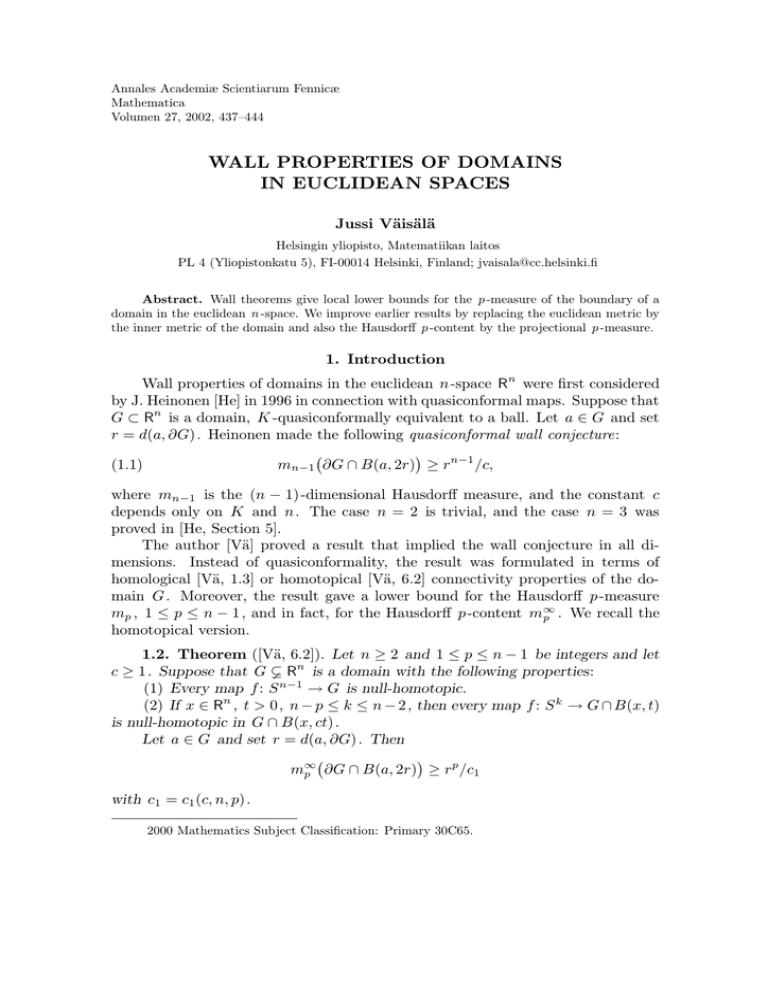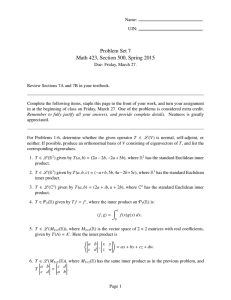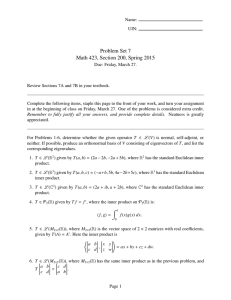WALL PROPERTIES OF DOMAINS IN EUCLIDEAN SPACES Jussi V¨ ais¨
advertisement

Annales Academiæ Scientiarum Fennicæ
Mathematica
Volumen 27, 2002, 437–444
WALL PROPERTIES OF DOMAINS
IN EUCLIDEAN SPACES
Jussi Väisälä
Helsingin yliopisto, Matematiikan laitos
PL 4 (Yliopistonkatu 5), FI-00014 Helsinki, Finland; jvaisala@cc.helsinki.fi
Abstract. Wall theorems give local lower bounds for the p -measure of the boundary of a
domain in the euclidean n -space. We improve earlier results by replacing the euclidean metric by
the inner metric of the domain and also the Hausdorff p -content by the projectional p -measure.
1. Introduction
Wall properties of domains in the euclidean n -space Rn were first considered
by J. Heinonen [He] in 1996 in connection with quasiconformal maps. Suppose that
G ⊂ Rn is a domain, K -quasiconformally equivalent to a ball. Let a ∈ G and set
r = d(a, ∂G) . Heinonen made the following quasiconformal wall conjecture:
¡
¢
(1.1)
mn−1 ∂G ∩ B(a, 2r) ≥ rn−1 /c,
where mn−1 is the (n − 1) -dimensional Hausdorff measure, and the constant c
depends only on K and n . The case n = 2 is trivial, and the case n = 3 was
proved in [He, Section 5].
The author [Vä] proved a result that implied the wall conjecture in all dimensions. Instead of quasiconformality, the result was formulated in terms of
homological [Vä, 1.3] or homotopical [Vä, 6.2] connectivity properties of the domain G . Moreover, the result gave a lower bound for the Hausdorff p -measure
mp , 1 ≤ p ≤ n − 1 , and in fact, for the Hausdorff p -content m∞
p . We recall the
homotopical version.
1.2. Theorem ([Vä, 6.2]). Let n ≥ 2 and 1 ≤ p ≤ n − 1 be integers and let
c ≥ 1 . Suppose that G Ã Rn is a domain with the following properties:
(1) Every map f : S n−1 → G is null-homotopic.
(2) If x ∈ Rn , t > 0 , n − p ≤ k ≤ n − 2 , then every map f : S k → G ∩ B(x, t)
is null-homotopic in G ∩ B(x, ct) .
Let a ∈ G and set r = d(a, ∂G) . Then
¡
¢
p
m∞
p ∂G ∩ B(a, 2r) ≥ r /c1
with c1 = c1 (c, n, p) .
2000 Mathematics Subject Classification: Primary 30C65.
438
Jussi Väisälä
A K -quasiconformal ball satisfies these conditions for 1 ≤ p ≤ n − 2 with
c = c(K, n) , and (1.1) follows. In the homological version, (1) and (2) are replaced
by
(1) Hn−1 (G) = 0 ,
¡
¢
¡
¢
(2) the natural homomorphisms Hk G∩B(x, t) → Hk G∩B(x, ct) are zero
for n − p ≤ k ≤ n − 2 .
In a recent paper [BK, 6.5], M. Bonk and P. Koskela proved an inner version
of (1.1), where the euclidean ball B(a, 2r) was replaced by a ball in the inner
length metric of G (and mn−1 by m∞
n−1 ).
The purpose of this paper is to prove inner versions of the results in [Vä].
We find it convenient to replace the Hausdorff content m∞
p by the projectional
measure µp , defined in 2.3. Since µp ≤ m∞
≤
m
,
the
new
results are somewhat
p
p
stronger than those in [Vä] also in the euclidean metric.
I thank M. Bonk for calling my attention to this problem.
2. Preliminaries
2.1. Notation. Open balls in Rn are written as B(x, r) where x is the center
and r is the radius. For a, b ∈ Rn , we let [a, b] denote the closed line segment with
endpoints a, b , and we set [a, b) = [a, b] \ {b} . For 1 ≤ p ≤ n , the family of all p dimensional linear subspaces of Rn is written as Gp (Rn ) . For E ∈ Gp (Rn ) , we let
πE : Rn → E denote the orthogonal projection. The distance between nonempty
subsets A, B of Rn is d(A, B) , and the diameter of a set A ⊂ Rn is d(A) . The
volume of the unit ball in Rn is α(n) .
2.2. Hausdorff measure and content. For A ⊂ Rn we let mp (A) denote
the Hausdorff (outer) p -measure of A , defined and normalized as in [Fe, 2.10.2],
and the Hausdorff p -content m∞
p (A) is defined similarly but without any restrictions on the diameters of the covering sets. Then m∞
p (A) ≤ mp (A) . We consider
only the case where p is an integer, 0 ≤ p ≤ n , and the normalization means that
mp (A) = m∞
p (A) is the Lebesgue (outer) p -measure of A whenever A lies in a
p -dimensional affine subspace of Rn .
2.3. Projectional measure. Let n ≥ p ≥ 1 be integers. The projectional
p -measure of a set A ⊂ Rn is the number
µp (A) = sup{mp (πE A): E ∈ Gp (Rn )}.
Since the diameter of a set is decreased in each πE , we have always
µp (A) ≤ m∞
p (A) ≤ mp (A),
but there are, for example, sets A ⊂ R2 with µ1 (A) = 0 < m∞
1 (A) ; see [Ma, 9.2].
It is easy to see that the set function µp is monotone and countably subadditive,
hence a measure in the sense of [Fe, 2.1.2].
Wall properties of domains in euclidean spaces
439
3. Projectional versions of the wall theorems
We show that one can replace the Hausdorff content m∞
p by the projectional
measure µp in the wall theorems of [Vä].
3.1. Wall theorem. The homological [Vä, 1.3], homotopical (1.2 and [Vä,
6.2]) and the quasiconformal [Vä, 1.11] wall theorems are true with m ∞
p replaced
by µp .
Proof. Inspection of the proofs of [Vä] shows that it suffices to prove a projectional version of the Grid lemma [Vä, 2.3]. This is done in 3.2 below. We recall
the notation of [Vä, 2.2].
For s > 0 let Ks be the natural decomposition of Rn into closed cubes of
side s . For 0 ≤ k ≤ n we let Ksk denote the union of all k -dimensional faces of
the members of Ks .
n
3.2. Grid lemma. Suppose that 1 ≤ p ≤ n , that s > 0 , and
¡n¢that A ⊂ R
p
is a set with µp (A) < s /N , where N is the binomial coefficient p . Then there
is a ∈ Rn such that A ∩ (Ksn−p + a) = ∅ .
Proof. We may assume that s = 1 . Let F be one of the N linear subspaces
of Rn spanned by p vectors of the standard basis (e1 , . . . , en ) . Set J = [0, 1)n ,
JF = πF J and
ª
S©
JF ∩ (πF A − w): w ∈ Zn ∩ F .
DF =
Since the p -cubes JF + w are disjoint and mp measurable, we obtain (see [HS,
10.9])
mp (DF ) ≤
X
w
¡
¢ X
¡
¢
mp JF ∩ (πF A − w) =
mp (JF + w) ∩ πF A
w
= mp (πF A) ≤ µp (A) < 1/N.
S
Set DF∗ = J∩πF−1 DF and D = F DF∗ . By Fubini’s theorem we obtain mn (DF∗ ) <
1/N , and hence mn (D) < 1 . Since K1n−p is the union of the sets πF−1 [Zn ∩ F ] ,
the lemma holds with any a ∈ J \ D .
3.3. Remarks. 1. Lemma 3.2 has three advantages compared with [Vä,
2.3]: (1) Since µp ≤ m∞
p , it is stronger, (2) the constant N is smaller than the
corresponding constant β(n, p) of [Vä, 2.3], (3) the proof is simpler.
2. In [Vä, 2.3] there is a misprint: s/β should be sp /β .
440
Jussi Väisälä
4. Wall properties and inner wall properties
4.1. Wall properties. Let c > 0 , and let n ≥ 2 and 1 ≤ p ≤ n − 1 be
integers. We say that a domain G Ã Rn has the (c, p) -wall property if
¡
¢
µp ∂G ∩ B(a, 2r) ≥ rp /c
¡
¢
whenever a ∈ G and r = d(a, ∂G) . Observe that since µp B(a, 2r) = α(p)(2r)p ,
we always have c ≥ 2−p /α(p) .
4.2. Inner wall properties. Let G ⊂ Rn be a domain. We let λ = λG
denote the inner length metric of G , defined by
λ(a, b) = inf l(γ),
γ
where l(γ) is the length of γ and the infimum is taken over all rectifiable arcs
γ joining a and b in G . The distance λ(a, b) is also defined if a ∈ G and b is
a boundary point of G , accessible from G by a rectifiable arc. For a ∈ G and
r > 0 , we let Bλ (a, r) denote the set of all x ∈ G such that λ(a, x) is defined and
λ(a, x) < r . Since λ(a, b) ≤ |a − b| , we always have Bλ (a, r) ⊂ B(a, r) .
We say that a domain G Ã Rn has the inner (c, p) -wall property if
¡
¢
µp ∂G ∩ Bλ (a, 2r) ≥ rp /c
whenever a ∈ G and r = d(a, ∂G) . Again c ≥ 2−p /α(p) .
Trivially, the (c, p) -wall property implies the inner (c, p) -wall property. The
purpose of this section is to prove the converse where, however, c must be replaced by a larger constant c0 (c, p) . This implies the inner version of the Wall
Theorem 3.1, given in 4.9.
4.3. Lemma. Let G Ã Rn be a domain, let p ∈ [1, n − 1] be an integer and
let s ≥ 2 . Suppose that
¡
¢
µp ∂G ∩ Bλ (a, sr) ≥ rp /c
whenever a ∈ G and r = d(a, ∂G) . Then G has the inner (c0 , p) -wall property
with c0 = (s − 1)p c .
Proof. Let a ∈ G and r = d(a, ∂G) . Choose a point b ∈ ∂G with |a − b| = r ,
and set
e = (b − a)/r, t = r/(s − 1), y = b − te.
Then d(y, ∂G) = t . It is easy to see that Bλ (y, st) ⊂ Bλ (a, 2r) . Hence
¡
¢
¡
¢
µp ∂G ∩ Bλ (a, 2r) ≥ µp ∂G ∩ Bλ (y, st) ≥ tp /c = r p /c0 .
4.4. Theorem. If a domain G Ã Rn has the (c, p) -wall property, it has the
inner (c0 , p) -wall property with c0 = c0 (c, p) .
Wall properties of domains in euclidean spaces
441
Proof. Let a ∈ G and r = d(a, ∂G) . It suffices to find an estimate
¡
¢
(4.5)
µp ∂G ∩ Bλ (a, sr) ≥ rp /c1 ,
where c1 and s ≥ 2 depend only on c and p , since the theorem then follows from
4.3 with c0 = (s − 1)p c1 . We shall prove (4.5) with the universal constant s = 49
and with c1 = 4 · 8p c , which yield c0 = 4 · 10p c .
We shall several times make use of the elementary inequality
√
(4.6)
|πE x| + |x − πE x| ≤ |x| 2 ,
valid for all x ∈ Rn and for all linear subspaces E ⊂ Rn .
We may assume that a = 0 . Choose a point b ∈ ∂G with |b| = r , and set
e = b/|b|,
t = r/8,
y = b − te = 7te,
A = ∂G ∩ B(y, 2t).
p
Since µp (A) ≥ tp /c , there is a subspace F ∈ Gp (Rn ) such that
/2c .
√ mp (π0F A) ≥ t √
0
Set π = πF , π = πF ⊥ . By (4.6) we have either |πy| ≤ |y|/ 2 or |π y| ≤ |y|/ 2 .
√
Case 1: |πy| ≤ |y|/ 2 . For each x ∈ A we have
√
|πx| ≤ |πy| + 2t ≤ 7t/ 2 + 2t < 7t < r,
and hence [0, πx] ⊂ G . Since x ∈ ∂G , there is a point zx ∈ ∂G ∩ [πx, x] with
[πx, zx ) ⊂ G . By (4.6) we obtain
√
¡
¢
λ(0, zx ) ≤ l [0, πx] ∪ [πx, zx ] ≤ |πx| + |πx − x| ≤ |x| 2
√
√
≤ (|y| + 2t) 2 = 9t 2 < 2r.
Setting A1 = {zx : x ∈ A} we thus have A1 ⊂ Bλ (0, 2r) and πA1 = πA . Hence
¡
¢
µp ∂G ∩ Bλ (0, 2r) ≥ mp (πA1 ) = mp (πA) ≥ tp /2c,
which implies (4.5) with s = 2 , c1 = 2 · 8p c .
√
Case 2: |π 0 y| ≤ |y|/ 2 . Set q = n − p and
B = B(y, 2t),
Z = πB + π 0 B,
Dx = πx + π 0 B
for x ∈ A . Then x ∈ Dx , and Dx is a q -disk of radius 2t with π 0 Dx = π 0 B . For
z ∈ Z we have
√
¡ √
¢
(4.7)
|π 0 z| ≤ |π 0 y| + 2t ≤ |y|/ 2 + 2t = 7/ 2 + 2 t < 7t < r.
Furthermore, by (4.6) we get
(4.8)
√
|πz| + |π 0 z| ≤ |πy| + |π 0 y| + 4t ≤ |y| 2 + 4t < 14t < 2r
for all z ∈ Z .
We consider two subcases, each of which contains two subsubcases.
442
Jussi Väisälä
Subcase 2a: p ≤ q .
Subsubcase 2a1. There is a point x ∈ A such that ∂G meets [w, π 0 w] for
each w ∈ Dx . Let w ∈ Dx . Then |π 0 w| < r by (4.7). Now there is a point
zw ∈ ∂G ∩ [π 0 w, w] with [π 0 w, zw ) ⊂ G . By (4.8) we obtain
λ(0, zw ) ≤ |π 0 w| + |π 0 w − zw | ≤ |π 0 w| + |π 0 w − w| < 2r.
Setting D = {zw : w ∈ Dx } we have D ⊂ ∂G ∩ Bλ (0, 2r) , and π 0 D = π 0 Dx is the
q -disk F ⊥ ∩ B(π 0 y, 2t) .
Since p ≤ q , we can choose a subspace E ∈ Gp (Rn ) with E ⊂ F ⊥ . Then
πE D is a p -disk of radius 2t , and thus
¡
¢
µp ∂G ∩ Bλ (0, 2r) ≥ mp (πE D) = α(p)2p tp .
Since 2p α(p) ≥ 1/c by 4.1, this gives (4.5) with s = 2 , c1 = 8p c .
Subsubcase 2a2. For each x ∈ A there is a point wx ∈ Dx such that ∂G ∩
[wx , π 0 wx ] = ∅ . Then [wx , π 0 wx ] ⊂ G . Since x ∈ ∂G , there is a point zx ∈
∂G ∩ [x, wx ] with [wx , zx ) ⊂ G . Since |wx − zx | ≤ |wx − x| ≤ d(Dx ) = 4t , we get
by (4.8)
λ(0, zx ) ≤ |π 0 wx | + |π 0 wx − wx | + |wx − zx | < 14t + 4t = 18t.
Hence the set A1 = {zx : x ∈ A} lies in ∂G ∩ Bλ (0, 9r/4) . Since πA1 = πA , we
obtain
µp (A1 ) ≥ mp (πA1 ) = mp (πA) ≥ tp /2c,
and (4.5) follows with s =
9
4
, c1 = 2 · 8 p c .
Subcase 2b: p > q . Since
dim(F ⊥ ∪ {y})⊥ = p − 1 ≥ p − q,
we can choose F1 ∈ Gp−q (Rn ) with F1 ⊂ (F ⊥ ∪ {y})⊥ . Setting E = F ⊥ + F1 we
have dim E = p and πE y = π 0 y .
Recall the notation Dx = πx + π 0 B for x ∈ A . Let C be the union
of
√ those
¢
¡
Dx for which ∂G ∩ [w, πE w] 6= ∅ for all w ∈ Dx . Then C ⊂ Z ⊂ B y, 2t 2 .
Subsubcase 2b1: mp (πE C) ≥ tp /4c . For each x ∈ C we have
√
√
√
|πE x| ≤ |πE y| + 2t 2 ≤ 7t/ 2 + 2t 2 < 8t = r;
hence [0, πE x] ⊂ G . Choose a point zx ∈ ∂G ∩ [πE x, x] such that [πE x, zx ) ⊂ G .
By (4.6) we obtain
√
λ(0, zx ) ≤ |πE x| + |πE x − zx | ≤ |πE x| + |πE x − x| ≤ |x| 2
√ ¢√
¡
≤ 7t + 2t 2 2 < 14t < 2r.
Hence the set C1 = {zx : x ∈ C} lies in ∂G ∩ Bλ (0, 2r) . Since
µp (C1 ) ≥ mp (πE C1 ) = mp (πE C) ≥ tp /4c,
we get (4.5) with s = 2 , c1 = 4 · 8p .
Wall properties of domains in euclidean spaces
443
−1
Subsubcase 2b2: mp (πE C) ≤ tp /4c . For v ∈ πE C set Q(v) = πE
{v} ∩ Z .
Since E ⊥ ⊂ F , we have for each x ∈ Q(v)
|πE ⊥ x − πE ⊥ y| ≤ |πx − πy| < 2t.
Thus Q(v) is contained in a q -disk of radius 2t . By Fubini’s theorem we obtain
mn (C) ≤
Z
πE C
¡
¢
mq Q(v) dmp (v) ≤ α(q)(2t)q mp (πE C) ≤ α(q)(2t)q tp /4c.
On the other hand, Fubini’s theorem also gives
mn (C) = mq (Dx )mp (πC) = α(q)(2t)q mp (πC),
and hence mp (πC) ≤ tp /4c . Since mp (πA) ≥ tp /2c , we obtain mp (π[A \ C]) ≥
tp /4c .
Let x ∈ A \ C . There is a point wx ∈ Dx such that ∂G ∩ [wx , πE wx ] = ∅ .
Since |πE wx | ≤ |πE y| + 3t = |π 0 y| + 3t < r , we have [wx , πE wx ] ⊂ G . Since
x ∈ ∂G , there is a point zx ∈ ∂G ∩ [x, wx ] with [wx , zx ) ⊂ G . Then |wx − zx | ≤
|wx − x| ≤ d(Dx ) ≤ 4t . By (4.6) we get
λ(0, zx ) ≤ |πE wx | + |πE wx − wx | + |wx − zx |
√
√ ¢√
¡
≤ |wx | 2 + 4t ≤ 7 + 2 2 t 2 + 4t < 18t.
Hence the set A1 = {zx : x ∈ A \ C} lies in Bλ (0, 9r/4) . Since
µp (A1 ) ≥ mp (πF A1 ) = mp (πF [A \ C]) ≥ tp /4c,
we get (4.5) with s = 9r/4 , c1 = 4 · 8p c .
4.9. Inner wall theorem. Suppose that a domain G Ã Rn satisfies the
hypotheses of one of the wall theorems [Vä, 1.3], [Vä, 6.2] (see 1.2) with a constant
c > 0 and an integer p ∈ [1, n − 1] . Then G has the inner (c0 , p) -wall property
with c0 = c0 (c, n, p) . If G is K -quasiconformally equivalent to a ball, then G has
the inner (c0 , n − 1) -wall property with c0 = c0 (K, n) .
Proof. The theorem follows from Theorems 3.1 and 4.4.
444
Jussi Väisälä
References
[BK]
[Fe]
[He]
[HS]
[Ma]
[Vä]
Bonk, M., and P. Koskela: Conformal metrics and size of the boundary. - Amer. J.
Math. (to appear).
Federer, H.: Geometric measure theory. - Springer, 1969.
Heinonen, J.: The boundary absolute continuity of quasiconformal mappings II. - Rev.
Mat. Iberoamericana 12, 1996, 697–725.
Hewitt, E., and K. Stromberg: Real and abstract analysis. - Springer, 1969.
Mattila, P.: Geometry of sets and measures in euclidean spaces. - Cambridge University
Press, 1995.
Väisälä, J.: The wall conjecture on domains in euclidean spaces. - Manuscripta Math.
93, 1997, 515–534.
Received 13 November 2001






